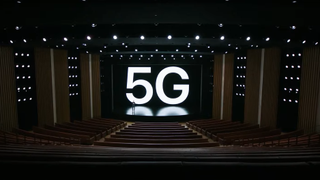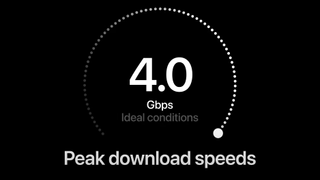Why 5G speeds on the iPhone 12 will likely disappoint
5G connectivity could end up disappointing more people than it please in the US.

When Apple launched the 5G-enabled iPhone 12 under the banner "5G just got real," it did so with a triumphant boast of the speeds that can be achieved via its A14 chipset, which the company claimed were up to 10 times faster than those available on 4G devices. But that was far from telling the whole story.
The reality is that current 5G download speeds in the United States are just 1.8 times faster than 4G LTE, according to data from Opensignal, a firm that tracks wireless network speeds around the world. Opensignal found that 4G LTE download speeds averaged out at 22Mbps, but when the same company tested the average speeds of users on a 5G tariff, speeds only increased to 33.4Mbps. That’s a decent boost, but it’s a long, long way from the 900Mbps 5G speeds that the likes of Verizon have been talking about.
- Best Prime Day deals: Top discounts on laptops, tablets and more
- iPhone 12 vs. iPhone 12 Pro: Which new Apple phone is best?
- iPhone 12 Pro and iPhone 12 Pro Max unveiled: Price, release date, specs and more
Why the disconnect?
This essentially comes down to two factors: coverage and the type of 5G currently available.
The 1-4Gbps 5G speeds that we’ve seen splashed over marketing campaigns are possible, but they are only possible when you are within a few hundred feet of a cell tower fitted with mmWave (high-band) 5G technology, and have no signal obstructions (because mmWave won’t penetrate walls, trees, or glass).

Once you move out of mmWave range, you’ll drop back down to a 4G/LTE connection, or low-band 5G, which operates at 600-700 MHz, and provides speeds a little higher than 4G LTE (30-250Mbps).
Low-band 5G speeds aren’t much better than 4G/LTE, and high-band doesn’t have the range or penetration to deliver a decent experience yet, so what about mid-band? Herein lies the problem, because the FCC only completed its mid-band spectrum auction at the end of August this year, which means it’s going to be a year or two before users can take full advantage of mid-band speeds.
Mid-band – the "Goldilocks" 5G
Mid-band 5G operates at between 2.5 and 3.7 GHz, which currently provide speeds of 100-900 Mbps, with each 5G cell tower providing service up to several miles in radius. And it’s this combination of speed and range that make it the perfect band for 5G, and has led to it being coined the "Goldilocks" of 5G connectivity.
Stay in the know with Laptop Mag
Get our in-depth reviews, helpful tips, great deals, and the biggest news stories delivered to your inbox.
If you find this a little confusing, you’re not the only one, because a recent survey of current iPhone users in the US, undertaken by testing company Global Wireless Solutions, found that almost half of iPhone users (49%) thought they already had 5G on their handsets (despite the 5G iPhone not having been released at the time!).
Why the FCC didn’t release 5G mid-band spectrum earlier and focused on low and high-band spectrum instead is anyone’s guess, but it has put the US well behind the likes of Europe, South Korea, and China when it comes to 5G connectivity.
And it means that users purchasing a 5G-enabled iPhone 12, rather than being blown away by blistering download speeds, could end up being severely disappointed with the results.
